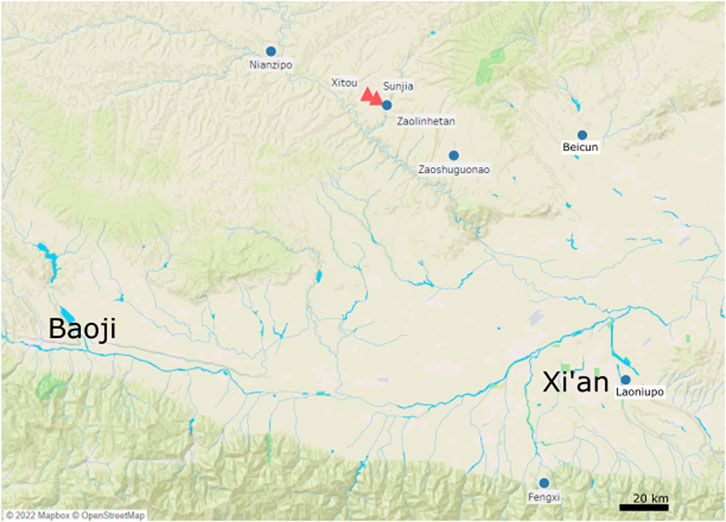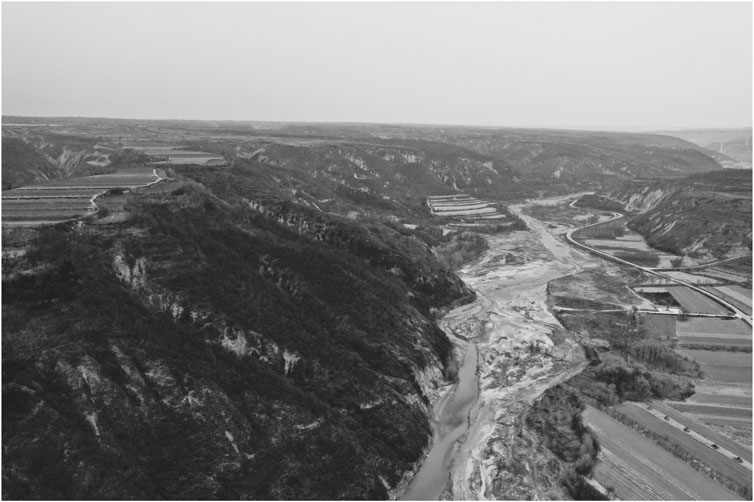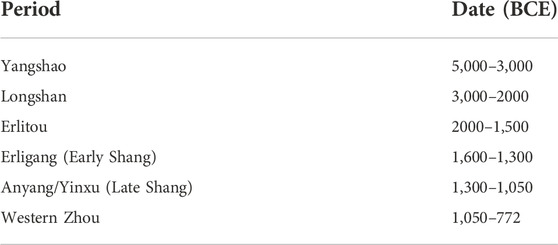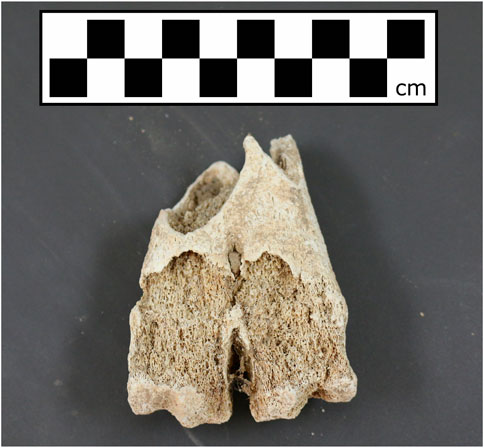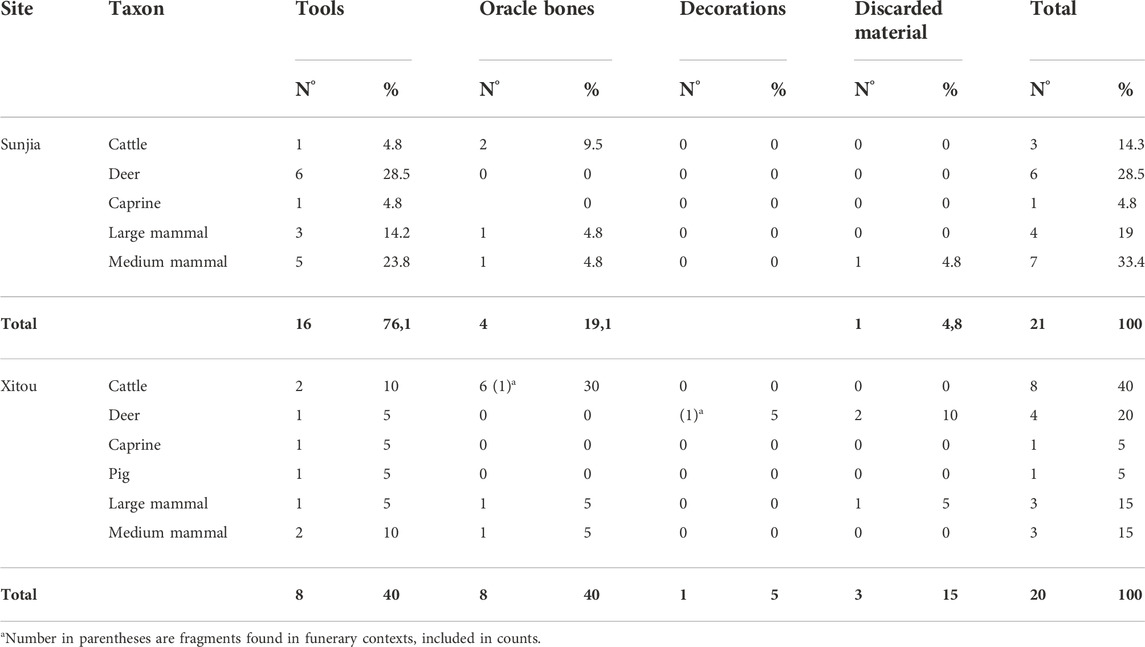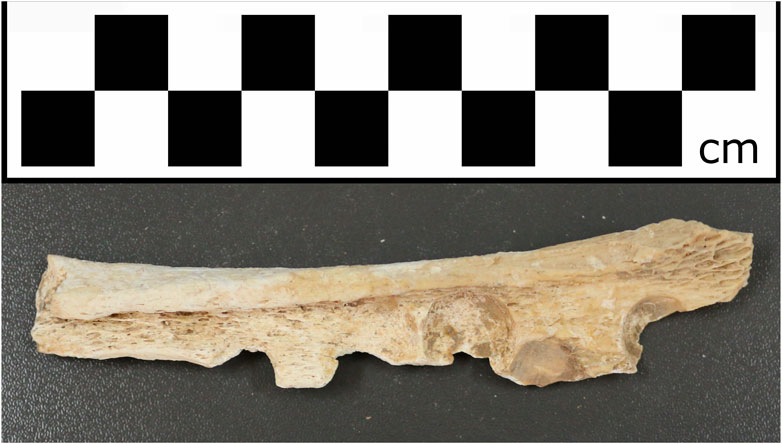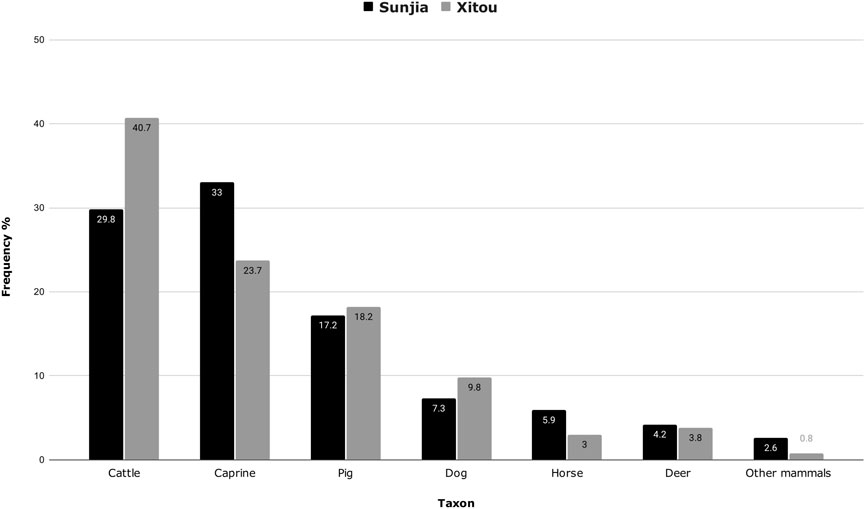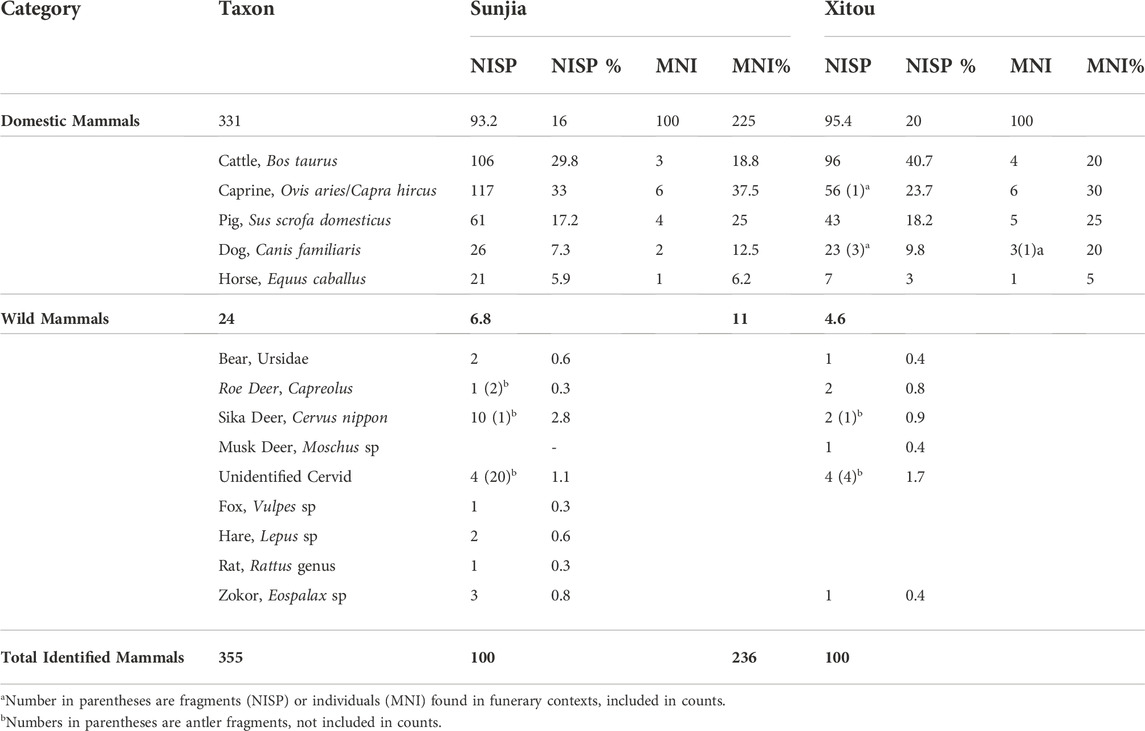- 1School of Cultural Heritage, Northwest University, Xi’an, China
- 2Key Laboratory of Cultural Heritage Research and Conservation, Ministry of Education, Xi’an, China
- 3China-Central Asia Belt and Road Joint Laboratory on Human and Environment Research, Xi’an, China
- 4Department of Archaeology, University of York, York, United Kingdom
This study examines faunal assemblages from the Proto-Zhou sites of Sunjia and Xitou, in the Jing River Valley (Central Shaanxi Province), to address questions concerning the exploitation of different animal resources in the context of the Shang-Zhou dynastic transition in the 11th century BCE. Although the assemblages from Sunjia and Xitou were small and sub-optimally preserved, this study demonstrates that the inclusion of such assemblages is essential to building upon our understanding of the human exploitation of animal resources. Our zooarchaeological analysis shows an increase in husbandry, with pig farming being complemented by extensive caprine and cattle herding. A diversified use of animal resources, and especially the larger number of bovids, could have been prompted by the need for a wider and more efficient exploitation of the immediate environment, in response to growing climatic deterioration, in addition to an increase in interactions with northern pastoral communities. Identified patterns of livestock biometry and relative taxonomic abundance show various degrees of agricultural engagement and a relatively complex livestock economy, suggesting the development of socio-economic complexity in the Jing River Valley in the late second millennium BCE.
1 Introduction
An understanding of the exploitation of animal resources is crucial to our appreciation of ancient subsistence strategies, land use, and regional social transformations (Crabtree, 1990; Zeder, 1991; Lhuillier and Mashkour, 2017). Zooarchaeology in Northern China has been consistently applied to the study of ancient remains, with the aim of understanding faunal temporal and spatial distribution, past environments and human-animal relationships (Yuan, 2015). Systematic studies on ancient domestication (Huang, 2010), regional trajectories (Flad et al., 2007; Yuan et al., 2007), secondary products (Li et al., 2014a; Li et al., 2014b; Brunson et al., 2016) and craftsmanship (Campbell et al., 2011; Hou et al., 2018) have been largely centered in the Neolithic and dynastic periods in the Central Plain (Huang, 2000; Li, 2011a; 2011b; Li et al., 2014a). Limited work has been done in other contexts, including Bronze Age Central Shaanxi, which has to date obfuscated the economic conditions underpinning the emergence of the Zhou as a political authority in the late 11th century BCE (Yuan, 2000; Zhongguo Shehui Kaxue Xueyuan Kaogu Yanjiushuo, 2007; Li et al., 2019, Li et al., 2020).
The Proto-Zhou Culture (ca. 1400–1050 BCE) refers to the cultural complex created by the Zhou people and their alliance in Northwest China before the formal establishment of the Zhou Dynasty (1050–256 BCE). In other words, it indicates the dry-farming communities that inhabited the central Loess Plateau during the late Shang Dynasty (1600–1050 BCE) (Huang et al., 2003; Cao, 2007). Epigraphic sources have consistently been used to identify the ancestral land of Zhou, the dominant idea being that it was located in the northern and middle reaches of the Jing River (Khayutina, 2020). According to written sources and inscriptions, the main Proto-Zhou centers include the Zhouyuan region, which encompasses present-day Qishan and Fufeng Counties, and Feng and Hao, located on the western and eastern banks of the Feng River, near Xi’an. Their location is supported by archaeological evidence (Zhang and Yin, 2004; Khayutina, 2010). The earliest Zhou centers, Tai, in the valley of the Wei River, and Bin, in the middle reaches of the Jing River, have not been precisely identified, although most scholars have located the Ancient Bin Area (Gu Bin di 古豳地) in a region roughly covering the present-day counties of Binzhou, Xunyi, Changwu and Chunhua (Zhang, 2004; Li, 2006; Niu 2017; Khayutina, 2020).
“The Archaeological Investigation of the Ancient Bin Area” project has identified and excavated several Proto-Zhou sites in the Jing River Valley, including Nianzipo (Changwu County) (Zhongguo Shehui Kaxue Xueyuan Kaogu Yanjiushuo, 2007), Zaoshugounao (Wang and Chen, 2010; Xibei Daxue Wenwhua Yichan Xueyuan yu Kaoguxue Xueyuan Zhongxin, 2012), Zaolinhetan (Dou et al., 2019) (both in Chunhua County), Xiaweiluo (Xibei Daxue Wenwhua Yichan Xueyuan yu Kaoguxue Xueyuan Zhongxin et al., 2006), Sunjia and Xitou (all three in Xunyi County) (Xibei Daxue Wenhua Yichan xueyuan et al., 2020; Xibei Daxue Wenhua Yichan xueyuan et al., 2021). Taxonomic typological comparison of structures and pottery material, sometimes combined with radiocarbon dating results, has allowed the attribution of these sites to the Proto-Zhou Culture. Sites excavated in the context of this project were among the first in the region at which significant zooarchaeological research was undertaken (Zhongguo Shehui Kaxue Xueyuan Kaogu Yanjiushuo, 2007; Li et al., 2019, 2020) (Figure 1).
The study of faunal assemblages has suggested that the ancient inhabitants of Central Shaanxi herded sheep and goats in the gullies and hills, and raised pigs on the plain and loess platforms, while also practicing some hunting and fishing (Cheng et al., 2017; Festa and Montheith, 2022). Results from the Zaoshugounao and Zaolinhetan assemblages have revealed that residents practiced intensive farming and animal husbandry in and around the settlements, complemented by extensive caprine herding on marginal lands (Li et al., 2019, 2020). By contrast, pigs would appear to have been important domesticated animals at Fengxi (Yuan, 2000), Nianzipo (Zhongguo Shehui Kaxue Xueyuan Kaogu Yanjiushuo, 2007) and Beicun (Cao, 2001), where relatively low ratios of bovids compared to pigs have been identified. Our analysis of the faunal assemblages from Sunjia and Xitou represents novel data on animal economies in the Jing River Valley during the second millennium BCE, which allows for a more solid understanding of the regional subsistence strategies in the context of the emergence of the Zhou authority.
1.1 Sunjia and Xitou
The Sunjia and Xitou sites are located in Zhanghong Town, in northwestern Xunyi County (Xianyang City, Shaanxi Province), along the north-western boundary of the Guanzhong Plain and the southern limits of the Loess Plateau (Shaanxi wenwuju 2012). This “transitional zone” is characterized by platforms, gullies, and hill ridges ranging from 960–1350 masl, which form a segmented natural landscape (Festa and Monteith, 2022). The local river, the Sanshui, runs diagonally across the territory from northeast to southwest before flowing into the Jing River (Figure 2). Although the hillsides have been relatively recently terraced, historically, this region would have only had limited land for cultivation.
Sunjia and Xitou are multi-phase settlements with cemeteries showing fairly constant use from the Neolithic period to historic times. The excavation report of Sunjia has not yet been published. The site is located ∼8 km northeast of the Yuandi Community. Preliminary excavations in 1994 discovered a pit containing Proto-Zhou pottery sherds (Lei, 2010) and, in 2017, further excavations uncovered various residential features, such as trash pits, ditches, and houses, and a number of joined-crotch li vessels (Zhang, 2004). Xitou is a large site located ∼1 km west of the Yuandi Community, with a total area of about 100 km2. Over the course of various excavation campaigns since the 1990s, it has been revealed that the site was occupied serially over the periods of Yangshao, Longshan, Shang, Western Zhou and even later (Xibei Daxue Wenhua Yichan xueyuan et al., 2020; Xibei Daxue Wenhua Yichan xueyuan et al., 2021; Shaanxi 2012; Guojia wenwuju 1998) (Table 1). In 2018, excavations were undertaken in the Yuzuipo sector of the south-eastern section of the Xitou site (hereafter abbreviated to Xitou) (Figure 3). An area of ca. 700 m2 was excavated and various structures, including houses (n = 4), ash pits (n = 128), ash ditches (n = 9) and tombs (n = 14) were uncovered. These features were found to contain a large number of ceramics, lithics and animal remains (Xibei Daxue Wenhua Yichan xueyuan et al., 2021). These animal remains constitute the faunal evidence examined in this paper. To date no radiocarbon dates have been published for either of these sites. Chronological attribution of the remains to the Late Shang period has been inferred from the stratigraphy and taxonomic typologies of the tombs, buildings, and ceramics therein. The relevant culture levels in Sunjia and Xitou show significant parallels with artefacts and structures excavated from the Nianzipo, Zoalinhetan and Zaoshugounao sites, for which radiocarbon dates have been published (Zhang, 2004; Gong, 2018; Xibei Daxue Wenhua Yichan xueyuan et al., 2020; Xibei Daxue Wenhua Yichan xueyuan et al., 2021).
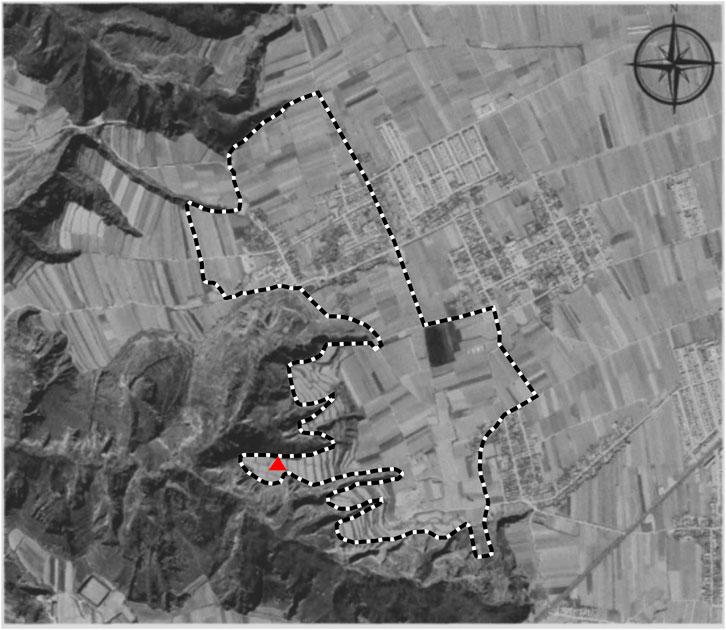
FIGURE 3. The area of Xitou. The red triangle indicates the Yuzuipo locale, from which our faunal evidence has been excavated. Adapted from Xibei Daxue Wenhua Yichan xueyuan et al. (2020).
2 Materials and methods
This study is based on the faunal remains excavated from Sunjia in 2017 and Xitou in 2018. Although mostly recovered from residential contexts, a few finds were discovered in four burials in Xitou (M2, M6, M7, and M12). Hand selection was employed during excavation, but no sieving. The animal bone assemblages totaled 1,097 fragments at Sunjia and 519 fragments at Xitou.
The analysis was conducted in two different locations: the zooarchaeology laboratory of Northwest University (Xi’an), and the Northwest University archaeology base in Xunyi County. Taphonomic processes—fragmentation, sub-aerial weathering, burning, gnawing—and human modifications were quantified for all fragments to evaluate the general preservation of the assemblages. The completeness of bones was recorded differently for identified and non-identified bones: the former was measured according to proportion of the whole bone (0.25, 0.25-0-5, 0.5-0.75, ≈1); for the latter maximum length measures were recorded. Sub-aerial weathering and burning were also recorded according to Behrensmeyer (1978) and Stiner et al. (1995), respectively. Worked bones were identified into the lowest identifiable taxonomic unit and classified, according to their possible function considering shape, size and (when possible) use-wear, into four main categories—tools, oracle bones, decorations, and discarded material.
Identification was attempted for every fragment using the reference collection of the zooarchaeological laboratory of Northwest University, online reference resources (e.g., archaeozoo.org) and published identification manuals (e.g., Hillson, 1992; France, 2009). All identified bones were used to calculate the number of identified specimens (NISP) and minimum number of individuals (MNI). NISP was used to quantify species abundance and was calculated using fragments identified to family and beyond following Clason (1972)’s method. By counting fragments that can be cross-mended as one, Clason’s method limits the risk of counting fragments from the same element more than once and, therefore, reduces the boost from large-size bones and animals. Considering the poor preservation of the faunal remains, the limited availability of reference specimens, and the uncertainties surrounding the standards to distinguish sheep and goats (Zeder and Pilaar, 2009; Zeder and Lapham, 2010; Salvagno and Albarella, 2017), the two were combined into the “caprine” category. MNI was calculated on the basis of diagnostic zones present (Dobney and Rielly, 1988). Because of the small number of faunal remains unearthed from graves in Xitou, they were considered along with those from the residential context in the counts of NISP and MNI, in order to provide an omnicomprehensive understanding of the taxonomic abundancy at the site. However, as the inclusion of fauna in funerary contexts implies intentional deposition, the provenance of the bones was signaled in the resulting counts and considered, when necessary, during the interpretation of the results.
Mortality profiles for cattle, pigs and caprines were generated based on bones epiphyseal fusion alongside tooth eruption and wear. Considering the fragmentary evidence, cattle dental aging was attempted using Jones and Sedler (2012), which works relatively well with loose teeth. Caprine mandibles were aged using Payne (1973), which identifies tooth eruption and wear stages for the lower deciduous premolar (dp4), permanent premolar (P4) and molars (M1, M2, and M3). Available dp4 and M3 from single individuals to which age stages could be assigned were also used. The information was then converted into a survivorship curve, which expresses the percentage of animals killed at each age. For pigs, we employed Lemoine et al. (2014)’s “specific system”, which allows to consider both mandibles and maxillae. Epiphyseal fusion analysis for cattle was carried out following O’Connor (2003), while for pigs Zeder et al. (2015) was employed, because it relates to Lemoine et al. (2014)’s dental aging system. Analysis on caprines was conducted by referring to Zeder (2006)’s system, which relates tooth eruption and wear to long bone fusion to refine age determination accuracy.
Measurements were taken for whole elements and undamaged parts following Von den Driesch (1976). Body-size of cattle and pigs was examined using the Log Standard Index (LSI) method. In spite of several imperfections (e.g., the assumption that all bones vary proportionally in size with the standard animal, neglecting other factors impacting the body proportions), the LSI method has the merit of increasing sample sizes, when few measurable specimens are available (Meadow, 1981, Meadow, 1984). Due to the lack of published measurement data from complete Chinese specimen skeletons, Degerbol and Fredskild (1970)’s female aurochs from Mesolithic Denmark, and Russel (1993)’s modern Hungarian female wild boar were used as standard animals for LSI analysis of cattle and pigs, respectively. Pigs’ body size and upper M3 measurements were also used to investigate the domestication status (Mayer, et al., 1998).
3 Results
3.1 Taphonomy
Taphonomic processes impact the preservation of faunal remains after the animal’s death and affect basic data as well as those from age profiles (Lyman, 1994; Lam et al., 2010). Table 2 Our assemblages were both fairly fragmented and extensively weathered, especially in Sunjia, where severe weathering affected more than 62% of the fragments (Behrensmeyer, 1978) (Figure 4). Assuming that sub-aerial weathering is irrelevant for buried bones (Reitz and Wing, 2008), most specimens in Sunjia and Xitou must have been exposed on the surface, instead of being rapidly buried. The fact that the remains recovered from burials lack weathering marks further supports this conclusion. All taxa had been subjected to weathering. A low rate of gnawing marks in Sunjia (2% of the fragments) contrasted with the high degree of weathering. Elsewhere, this phenomenon has been associated with abandonment phases during which human and animal activities were absent (Madgwick and Mulville, 2015). This is plausible, as some settlements in the regions, such as Jiangzhai (Lintong, Xi’an), appear to have been abandoned for some time before being reoccupied decades or centuries later (Peterson and Shelach, 2012). Another possibility is that some areas were fenced allowing weathering to occur but preventing animals’ access (Lawson et al., 2000). Some gnawing marks may have also been erased by weathering processes, which were particularly severe in Sunjia. In Xitou, the rate of gnawing marks was higher (7% of the fragments), and this is consistent with the higher presence of carnivores at the site (see below). In both sites, the limited evidence of burning activity was evenly distributed taxonomically, and mostly included bones burned to dark-brown or black (Stiner et al. (1995)’s stage 3), with only some semi-calcined and calcined specimens (Stiner et al. (1995)’s stages 4–6). Their presence, in association with cultural features, including residential structures and bones/antlers artefacts, suggests that these burned bones were products of anthropogenic activities (David, 1990).
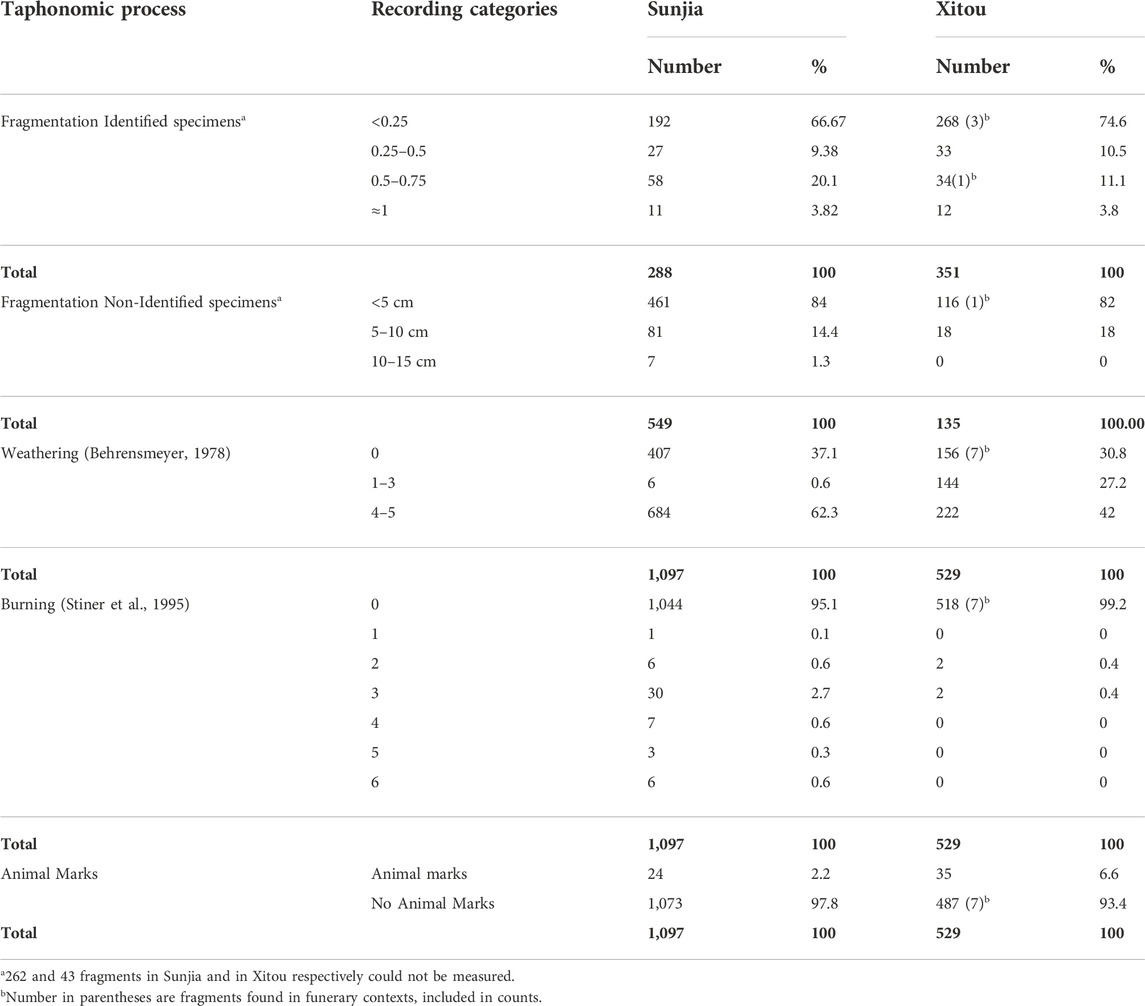
TABLE 2. Quantification of the taphonomic processes affecting the faunal remains in Sunjia and Xitou.
3.2 Worked bones
A total of 16 and 8 tools, and 4 and 8 ritual objects were recovered from Sunjia and Xitou respectively, forming ca. 2% of the fragments in each site. Human modifications were unevenly distributed across taxa, cattle and deer being the most popular. Table 3 Cattle scapulae were used to make oracle bones. Deer elements—mostly antlers, but also bones and teeth—were used as tools and decorative items. In Xitou, the assemblage of worked bones was more varied, occasionally including pig specimens. A fair number of modified bones came from large and medium mammals which could not be identified to species (Figure 5). Notably, one cattle oracle bone and one decorated deer tooth were discovered in graves M7 and M12, respectively. Discarded material found in both sites suggests local production activity.
3.3 Taxonomy
By considering fragments that could be cross-mended as one (Clason, 1972), we counted 614 and 420 specimens in Sunjia and Xitou respectively. Mammals dominated the two assemblages (98.9% and 100% in Sunjia and Xitou, respectively). The remaining finds in Sunjia consisted of birds (n = 2; 0.3%) and shellfish (n = 5; 0.8%). The overall paucity of remains of small-sized animals and small bones in the assemblages may relate to the lack of sieving on site. Around half of the specimens could not be identified beyond family. Such identification was possible for 355 and 236 specimens in Sunjia and Xitou, respectively (Figure 6; Table 4). Among the finds in Xitou, identified faunal remains from graves were only 4 (1.6% NISP). Few wild mammal species were observed (Sunjia, 7% NISP; Xitou, 5% NISP), more than half of which were cervids. The domestic assemblage was prevalent in both sites (Sunjia, 93% NISP; Xitou, 95% NISP) and it was remarkably homogeneous, with only a few taxa represented. Domestic cattle had a significant presence (Sunjia, 30% NISP; Xitou, 41% NISP), although caprine NISP was higher in Sunjia (33% NISP). Pigs made up 17% NISP in Sunjia and 18% NISP in Xitou, respectively. A fair number of dog remains were found (Sunjia, 7% NISP; Xitou, 10% NISP). Notably, 3 fragments were from grave M2 in Xitou (1.3% MNI). The least represented taxon was horse (Sunjia, 6% NISP; Xitou, 3% NISP).
MNI of domesticated animals (cattle, caprines, pig, dog, and horse) showed a general consistency across the two sites (Table 4). Caprines were the best represented category in both assemblages (Sunjia, 37.5% MNI; Xitou, 29% MNI), followed by pigs (Sunjia, 25% MNI; Xitou, 24% MNI) and cattle (19% MNI in both sites). The MNI slightly differed from the NISP, especially in Xitou, where cattle elements were predominant. Breakage analysis showed that the assemblages were quite fragmented, suggesting a possible boost in the cattle NISP proportion. For dogs, a relatively high MNI in Xitou (20% MNI) was due to the presence of 4 mandibles, one of which (alongside one cranial bone and one vertebra) came from grave M2. The MNI value for dogs in Sunjia was lower, but still significant (12.5% MNI). The horse was the least represented taxon by MNI (Sunjia, 6.2% MNI; Xitou, 5% MNI).
3.4 Age at death
Mortality data allows the identification of unnatural mortality patterns among animal populations, which can be attributed to human decisions and related to domestication and herd management (Li et al., 2014a; Reitz and Wing, 2008). The small assemblages prevent more than a very general idea of mortality patterns for the main domestic taxa in Sunjia and Xitou.
3.4.1 Cattle
One mandible from Sunjia gave a rough estimation of death age at ca. 2 years old. 3 deciduous teeth in Xitou could be related to one or more relatively young individuals. Another 4 upper M2 and 4 lower M2 were available for examination in Sunjia and Xitou, respectively. They were all in wear, making the individuals possibly older than 18 months (Jones and Sadler, 2012). The tiny sample impacted the overall significance of the epiphyseal fusion analysis results, causing some slightly nonsensical outputs (O’Connor, 2003) (Supplementary Figure S1). Overall, mortality data showed a gradual attrition with a significant proportion of older specimens.
3.4.2 Caprine
Mandibles from Sunjia (3) and Xitou (8) were examined, along with 4 lower loose teeth—3 M3 and 1 dP4 in Sunjia; 1 dP4 and 2 M3 in Xitou (Payne, 1973). The Xitou assemblage lacked data for several age groups. However, the overall dental analysis results showed a fairly gradual killing pattern for both sites (Supplementary Figure S2). In Xitou, usable samples for epiphyseal fusion analysis were only available for Zeder (2006)’s fusion groups D and E—respectively representing fusion at 18–30 months and 30–48 months. 3/8 and 2/7 specimens were fused or fusing respectively, collectively suggesting that around a third of the individuals survived beyond these age ranges. Epiphyseal fusion analysis results for Sunjia showed an early kill-off at face value, however, they were skewed by a couple of fairly complete juveniles found in a single unit, which made up ca. 40% of the sample size.
3.4.3 Pigs
Survivorship curves for pigs show a relatively gradual attrition, insofar as the very small samples can be trusted. The examination of 3 mandibles and 3 maxillae from Sunjia and 7 mandibles and 1 maxilla from Xitou, showed a fair representation of younger (ca. 12 months) and older individuals (16–30 months) (Lemoine et al., 2014) (Supplementary Figure S3) Epiphyseal fusion analysis was attempted using Zeder et al. (2015) but the numbers (n = 5 in each site) were just too small to be meaningful.
3.5 Size
Postcranial measurements of cattle bones showed that all of the specimens at Sunjia were smaller than all of those at Xitou—the LSI values ranging from −0.40 to −0.15 and from −0.15 to 0.06 respectively (Figure 7A; Supplementary Table S1). Our assemblages did not comprise a sufficient number of long bones with fused proximal and distal epiphyses, which would have been optimal specimens for measurement (Von den Driesch, 1976). The analysis was largely conducted on partial long bones shafts with one of the two epiphyses fused, phalanges, and other elements, such as astragali and one atlas. In spite of the obvious limitations, the size variation was statistically significant (Mann-Whitney U-test: U=0, p=0.0040).
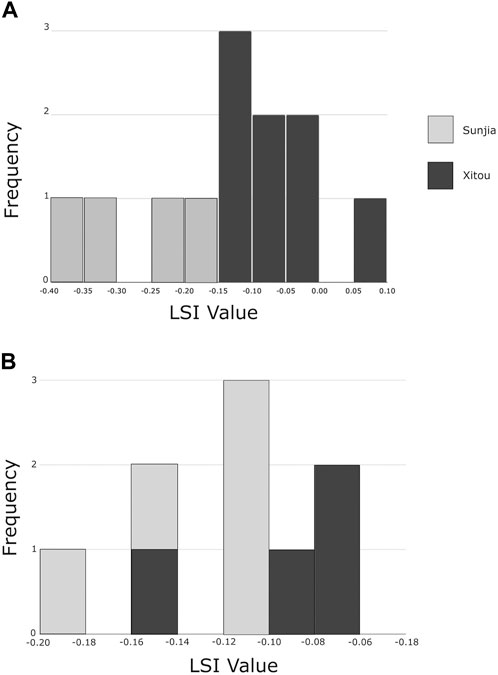
FIGURE 7. Distribution of LSI values for cattle (A) and pigs (B)’ elements in Sunjia and Xitou. Standard animal data from Degerbol and Fredskild (1970) and Russel (1993), respectively.
A similar trend was observed for pigs, although there was some overlap, and the difference was not statistically significant (U=3, p=0.1111) (Figure 7B; Supplementary Table S2). Pigs were identified as domestic. They were invariably smaller than the female wild boar taken as reference animal. Moreover, 3 upper M3 and 2 lower M3 measurements were consistent with Mayer et al. (1998)’s values for domestic pigs. The sample was, however, very small and might not fairly represent the ancient assemblage of suines. Data for sheep were insufficient for a comparison (n = 2 in Xitou).
4 Discussion
This paper has demonstrated that taxonomic abundance and some information about human exploitation of animal resources can be inferred from two small and poorly preserved assemblages. Sunjia and Xitou were rather consistent in terms of taxonomic composition. Both assemblages were dominated by domestic species, though some wild fauna was also present, suggesting that the economy was based on husbandry supplemented with some hunting and fishing. Cattle and caprines dominated the assemblages in Sunjia and Xitou. Our results are consistent with those obtained by Li et al. (2019), and Li et al. (2020) for the coeval neighboring sites of Zaoshugounao and Zaolinhetan (Figure 8; Supplementary Table S3), suggesting a growing importance of these two taxa in the region during the Late Shang period. Increasing bovid herding marks a clear difference in comparison with previous periods, when pigs were predominant. In Central Shaanxi pigs were domesticated relatively early, probably in the Mid-Neolithic (Barton et al., 2009), and their importance grew during the Yangshao and Longshang periods (Hu, 2001; Hu et al., 2011; Wang et al., 2013). A slight, though steady, increase in bovids, at the expense of pigs, has been documented from the end of the Longshan period (Hu, 2001; Hu et al., 2008; Hu et al., 2016), and according to our results, became more dramatic in the late second millennium BCE (for a summary see Festa and Monteith (2022)).
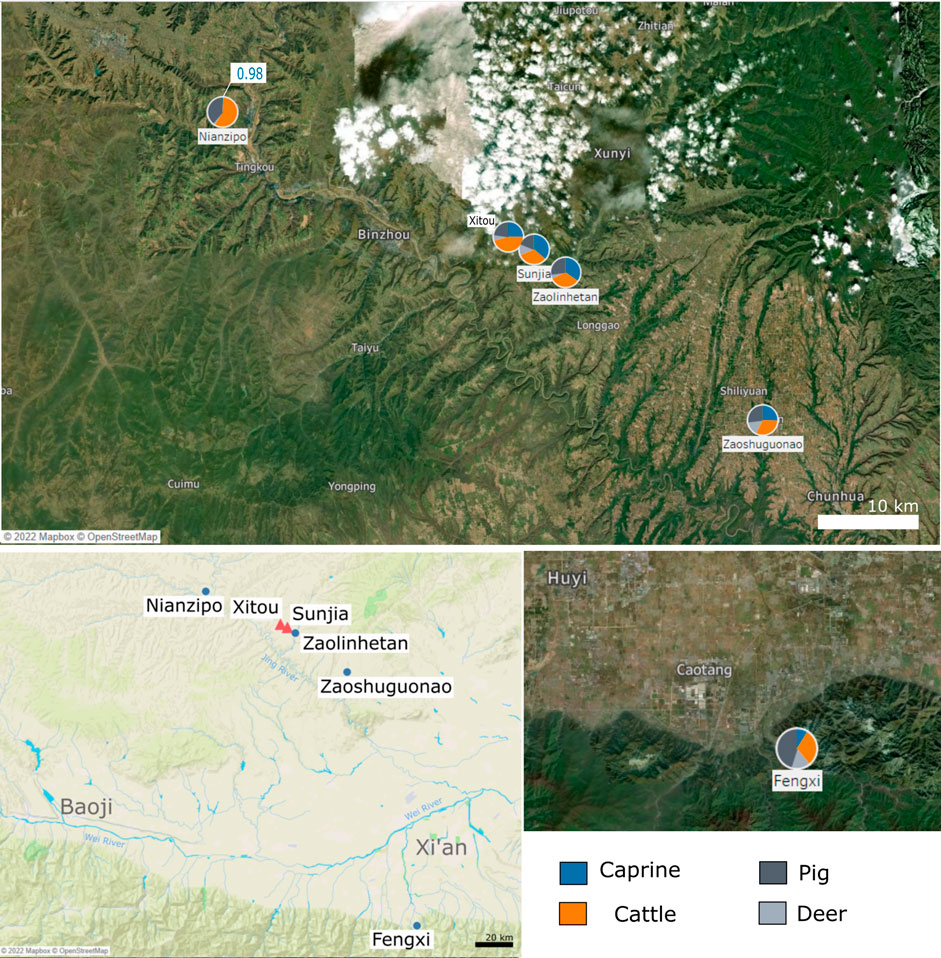
FIGURE 8. Relative taxonomic frequency for the main domestic taxa (pigs, caprine and cattle) and deer by %NISP in the sites mentioned in this study: Sunjia and Xitou (this study), Nianzipo (Zhongguo Shehui Kaxue Xueyuan Kaogu Yanjiushuo, 2007), Zaolinhetan, Zaoshuguonao (Li et al., 2020). Bottom right: Relative taxonomic frequency for the main domestic taxa (pigs, caprine and cattle) and deer by %NISP in Fengxi (Yuan, 2000). Data from the sites of Beicun and Laoniupo were not complete and could not be plotted with those from the other sites. Bottom left. Location of the mentioned sites (Tableau, F. Monteith)
The exploitation strategies present at the sites of Sunjia and Xitou may have been dependent on multiple simultaneous variables. The shift to bovid husbandry could be related to the increasingly cold and dry climate, which followed the Holocene Climatic Optimum, and which could have had an impact on livestock management. While caprines and cattle are fairly tolerant of arid conditions, pigs require a plentiful and dependable supply of water (Burrin, 2001). Also, under cold and arid conditions, agricultural productivity would have declined, prompting a wider and more diversified use of the landscape, including the expansion into marginal lands, which would have been easier with bovid herding (Festa and Monteith, 2022). An et al. (2005) and Huang et al. (2004) have shown that climatic deterioration in the Loess Plateau caused many rain-fed agricultural economies to shift toward agro-pastoralism and mobile pastoralism from the beginning of the second millennium BCE. Similar conclusions were reached by research in Central Asia and Northern China (Frachetti et al., 2017; Wang et al., 2021). Although the residents of the Jing River Valley practiced agriculture and raised some pigs (Lu and Zhang, 2008; Li et al., 2009; Chen et al., 2019), the growing importance of cattle and caprine husbandry may have allowed for a more extensive exploitation of the immediate environment in response to regional climatic changes.
The Proto-Zhou faunal assemblage from the site of Fengxi (Xi’an), located in the plain of the Wei River Valley, includes a relatively larger proportion of pigs than Sunjia and Xitou (Yuan, 2000). Similarly, in Laoniupo (Xi’an), also located in the plain, pig remains were well represented. These two assemblages present certain limitations, one being the sample size of the former, which was very small, including less than 200 elements. Additionally, the assemblage from Fengxi was discovered over the course of 50 years of intermittent archaeological excavations, with recovery and recording protocols not followed to a modern standard: the context in which the bones were and some relevant data are, therefore, controversial. The bones at Laoniupo were mostly found in funerary contexts, which implies intentional selection (Zhang et al., 2007). The variations in the faunal assemblages between these and our sites may, nevertheless, indicate an adaptation to distinct eco-topographic conditions—the former being on a broad flat plain and the latter in a hilly region consisting of gullies and loess platforms. The climatic deterioration following the Climatic Optimum may have affected agriculture to different degrees in the plain and the hilly transitional region to the north, resulting in a different response by the residents of the two areas. Deterioration in climatic conditions would have led to cultivation being less productive in the Jing River valley—where arable land was more limited to begin with—than on the plain. Therefore, while the communities in the plain could rely on a complementary strategy of mixed millet-rice agriculture and pig husbandry (Zhang et al., 2010), the residents of Sunjia and Xitou may have diversified the exploitation of animal resources to cope with new climatic conditions. Bovid husbandry would have been quite efficient, because these animals do not compete with humans for food, do not require copious amounts of water, and could also be used for secondary products.
It is however, noteworthy, that suines, along with deer, were well represented at the sites of Beicun (Yao County) and Nianzipo (Changwu County), which were also located in the hilly region to the north of the Guanzhong Plain. Beicun was reported only in terms of MNI and based on a specific selection of skeletal elements, which not necessarily represent the whole assemblage (Cao, 2001). Additionally, the context in which the skeletal elements were found is controversial and it is unclear whether these bones were from a residential or a funerary context, or both. Similarly, the assemblage from Nianzipo, made up mostly of long bones shafts with traces of human modifications, was retrieved from specific contexts associated with bone production, and may not be fully representative of the whole assemblage (Zhongguo Shehui Kaxue Xueyuan Kaogu Yanjiushuo, 2007). Notwithstanding, the high proportion of pigs at these sites suggests that cultural preferences may have influenced the regional animal exploitation strategies (Figure 8; Supplementary Table S3).
Increasing caprine and cattle herding in Sunjia and Xitou may also have been due to the influence of neighboring pastoral communities in the north. In the second-first millennium BCE mobile and semi-mobile pastoralism dramatically increased, and small and large-scale population movements created a solid network of interaction across Central Asia, Northwest China and Mongolia (Frachetti et al., 2017; Høisæter, 2017). In particular, the growing importance of bovids in the Jing River Valley may be related to the southern migration of pastoralist communities from the Northern Loess Plateau and the Mongolian Plateau. The existence of relations between the residents of Central Shaanxi and those inhabiting the northern regions has been recorded in ancient texts, such as Shiji Zhou Benji (史记·周本纪) (Huang et al., 2003; Khayutina, 2020). Most importantly, such interactions are documented by archaeological evidence of steppe-type of artefacts in several Proto-Zhou sites in Central Shaanxi (Zhang, 2004, Zhang, 2016; Wang and Chen, 2010).
The relatively gradual attrition shown by survivorship curves in Sunjia and Xitou contrasts with a planned and specialized meat production and suggests that the animals were exploited also for their secondary products. However, more data will be required to confirm this supposition. Evidence of worked bones indicates that some taxa were exploited for ritual purposes. For example, cattle scapulae were used to make oracle bones. The Shang used cattle scapulae and turtle shells as divinatory tools (Hou et al., 2018), however at our Proto-Zhou cultural sites only the former was found. Similar finds were recorded at Zaoshugounao and Zaolinhetan (Li et al., 2020), signaling some difference between the Shang and the Proto-Zhou in terms of ritual practices. The percentage of oracle bones in Sunjia (0.4% of the fragments) and Xitou (1.5% of the fragments) was comparable to coeval sites at Zaoshugounao (0.5% NISP) and Zaolinhetan (1.5% NISP) (Li et al., 2020), but lower than at Nianzipo (Changwu County) (3% NISP), where specimens made of horse and other animals’ scapulae were also found (Zhongguo Shehui Kaxue Xueyuan Kaogu Yanjiushuo, 2007). This may indicate a certain degree of ritual variability in the region, and, at the same time, reflect a decline of Shang practices in some areas of the Jing River Valley, in favor of other divinatory systems, such as that by hexagrams, mentioned in written sources (Khayutina, 2020). Only one fragmented oracle bone was found in the filling of grave M7 in Xitou. This was the only cattle remain recovered from our mortuary contexts, suggesting the development of different ritual practices compared to the Shang period, when whole or dismembered cattle were placed in graves (Lu, 2015; Hou et al., 2019). This inference is not only based on faunal assemblages from the four graves examined in this study, but also on comparable finds at Zaoshuguonao (Li et al., 2020). By contrast, the discovery of three bones belonging to (likely) one young dog in grave M2 in Xitou seems to finds parallels with dog mortuary depositions of the Shang (Li and Campbell, 2019), further supporting the variety of ritual traditions present in the Jing River Valley in the late 11th century BCE.
Despite the close proximity (∼4 km) and the shared topography and climate, a significant variation in cattle body size was observed between Sunjia and Xitou. In spite of the small assemblage and the above-mentioned limitations concerning the bones selection, this distinction is quite remarkable and it is worthy to be discussed in terms of extensive/intensive subsistence practices. As discussed above, in the late second millennium BCE, new economic strategies developed in the Jing River valley as a response to climatic changes, which brough about a certain degree of reorganization of the rural landscape and promoted the exploitation of more marginal lands. Archaeobotanical data for Xitou and Sunjia are currently not available, however, crop cultivation and consumption in the region has been demonstrated by archaeobotanical and isotope research results from neighboring Proto-Zhou sites (Lan 2017; Chen et al., 2019), and various degrees of reliance on agriculture have been discussed by Li et al. (2020) for the Zaoshuguonao and Zaolinhetan sites. If this was the case, foddering and breeding strategies would have been adjusted to different farming systems, affecting the animal size (Trentacoste, 2020). Different degrees of engagement in agricultural practice would have had a significant impact on localized animal exploitation, in particular, the use of cattle. A more intense and extensive agricultural activity would have favored animal labour in the fields, and, therefore, the investment in large specimens, potentially even oxen, for traction, which would have significantly increased land productivity; by contrast, small-scale agricultural systems would have incentivized human labor, and, therefore, the exploitation of smaller and cheaper cows for secondary products and light work (Bogaard et al., 2019; Trentacoste et al., 2021). The use of cattle for traction in Northern China during the late Shang period has been demonstrated by paleopathological studies on animal bones (Lin et al., 2018), however, the poor conditions of our assemblages hampered such analysis. In the absence of this data, it might be possible to use the size difference in cattle to differentiate between economic structures (Trentacoste, et al., 2021): a larger, more complex agricultural center, such as Xitou, would have required sizable animals, while in smaller settlements, such as Sunjia, smaller less-demanding female specimens, would have beeen preferred.
A non-statistically significant, yet notable, variation in pig size was identified between the sites of Sunjia and Xitou, with the former generally presenting smaller specimens than the latter. Although the sample size used in this study was small, this variation can signal different animal husbandry practices at the two sites. Chen et al. (2014)’s isotopic analyses of pig bones from the Mid-Late Neolithic sites of Dongying and Wayaogou, in the Wei River valley, have shown various feeding strategies in the region, with some pigs kept on intensive foddering, whereas others received less millet fodder. If the occupants of Sunjia and Xitou engaged in agriculture to different degrees, this may have had an impact on pig husbandry strategies, as less productivity would have left less surplus for pigs. Different feeding strategies would, in turn, have influenced the animals’ size.
The argument that the residents of the two sites may have relied on different agricultural and livestock management strategies is further suggested by the higher caprine/pig ratio by NISP in Sunjia (1.9), compared to that in Xitou (1.3), which would indicate a lower degree of agricultural engagement in the former site (Miller 1997). Considering that the two sites are only about 4 km apart and share environmental and climatic conditions, different economic strategies could have epended, at least partially, on social, cultural and political factors.
Wild animals were scarce, particularly in Xitou, where the dearth of arrowheads from the archaeological context further suggests limited hunting (Xibei Daxue Wenhua Yichan xueyuan et al., 2020). A few shell fragments constitute the only evidence of aquatic resource exploitation. This is unexpected given the large regional water system and the fair use of mollusks and fish documented from various sites in Central Shaanxi, both earlier than, and contemporary to, Sunjia and Xitou (Cheng et al., 2017; Li et al., 2020). This lack in our assemblages is presumably due to poor sieving and taphonomic agents. The relative paucity of wild taxa in our sites is in line with regional zooarchaeological and paleodietary research, which has shown that while hunting and fishing were practiced in the Neolithic, their importance declined during the Longshan period, possibly due to population growth and the increasing demand for meat, both for consumption and ritual purposes (Cheng et al., 2017). The decrease continued during the Late Shang period, when hunting and fishing may have become less related to the need for food (Li et al., 2021; Festa and Monteith, 2022) (Figure 9; Supplementary Table S3). Ancient texts and archaeological evidence indicate that hunting, in particular, was a significant social activity during the Shang and Zhou dynastic periods (Cheng et al., 2017; Fiskesjö, 2001). Most importantly, faunal evidence from Sunjia and Xitou indicates that wild taxa, especially deer, were exploited for tool-making, supporting Li et al. (2021)’s argument of a shift occurred in the cervids regional exploitation, from meat to antlers. The discovery of some unworked post-cranial elements from deer associated with tools made of antlers—and to a lesser extent, bones and teeth—and debris suggests that local residents hunted cervids and produced artefacts locally.
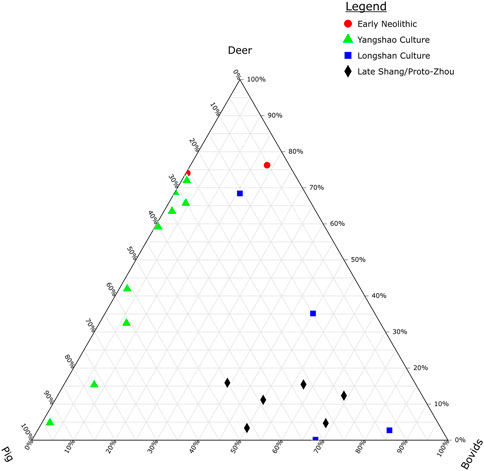
FIGURE 9. Deer, pigs and bovids (domestic cattle and caprine) relative taxonomic abundance variation across time in the Jing River Valley. Data from Li et al. (2020); Zhongguo Shehui Kaxue Xueyuan Kaogu Yanjiushuo (2007); Yuan, (2000); Wang et al. (2013); Hu, (2001); Hu et al. (2011, 2008, 2016), and this study Plot made with TernaryPlot (TernaryPlot.com).
5 Conclusion
Although the faunal remains from Sunjia and Xitou were sub-optimally preserved, their analysis is an important addition to zooarchaeological research as it represents a novel interrogation of micro-regional variation in the exploitation of animal resources in the Jing River valley in the Proto-Zhou period. A growing importance of bovids was identified at the sites. A diversified use of animal resources may have been prompted by the local population’s need to exploit the immediate and peripheral environment more efficiently, in response to the climatic deterioration following the Climatic Optimum. Interactions with northern communities of pastoralists, which migrated southward from the northern Loess Plateau and the Mongolian Plateau, could also have promoted more intensive bovid husbandry in the region.
A diversified use of animal resources and a wider and more efficient exploitation of the immediate environment, in addition to the alliances with neighboring communities, may have underpinned the socio-economic foundation behind the emergence of the Zhou as a political power. Li et al. (2020) speculate that diverse faunal use could reflect the development of economic and social complexity in the Jing River Valley in the late second millennium BCE. Such a conclusion was supported by our research results. Patterns of livestock biometry and relative taxonomic abundance in Sunjia and Xitou indicate that the residents of the two sites may have engaged in agriculture to different degrees and relied on different livestock management strategies. Xitou would have been a larger agricultural center, while Sunjia would have been a smaller settlement. This distinction suggests the development of some degree of regional social complexity in the Jing River Valley in the late second millennium BCE. While this study has demonstrated that variations in faunal exploitation strategies can inform socio-economic developments, these should be the subjects for further investigation, when more zooarchaeological results will be considered along with relevant archaeological evidence.
Data availability statement
The original contributions presented in the study are included in the article/Supplementary Materials, further inquiries can be directed to the corresponding author.
Author contributions
Conceptualization, MF and YL; methodology, MF and YL; formal analysis, MF, DO, QW, TZ, and YL; resources, HD, BL, and YL; data curation, MF; writing—original draft preparation, MF; writing—review and editing, MF, DO, FM, and YL; visualization, MF and FM; project administration, HD; funding acquisition, MF, HD, and YL. All authors have read and agreed to the published version of the manuscript.
Funding
This research was supported by the 111 Project (D18004), the General Project of the Chinese Academy of History Key Historical Research Project of the National Social Science (21@WTK005), National Foreign Young Talents Program (QN20200241002), the Key Research and Development Plan of Ningxia (2020BFG02008), the University Youth Innovation Team of Shaanxi and the Young Scholar Professional Support Program of Northwest University.
Acknowledgments
We are grateful to Professors Wang Zhen, Li Cheng and the Northwest University team working at the Xunyi base for the assistance during the collection of the faunal material. Xiao Jiarui is gratefully acknowledged for providing Figure 2. We are grateful to the two reviewers for the insightful comments on our manuscript.
Conflict of interest
The authors declare that the research was conducted in the absence of any commercial or financial relationships that could be construed as a potential conflict of interest.
Publisher’s note
All claims expressed in this article are solely those of the authors and do not necessarily represent those of their affiliated organizations, or those of the publisher, the editors and the reviewers. Any product that may be evaluated in this article, or claim that may be made by its manufacturer, is not guaranteed or endorsed by the publisher.
Supplementary material
The Supplementary Material for this article can be found online at: https://www.frontiersin.org/articles/10.3389/feart.2022.1072897/full#supplementary-material
References
An, C., Tang, L., Barton, L., and Chen, C. (2005). Climate change and cultural response around 4000Cal yr B.P. in the Western part of Chinese Loess Plateau. Quat. Res. 63, 347–352. doi:10.1016/j.yqres.2005.02.004
Barton, L., Newsome, S. D., Chen, F., Wang, H., Guilderson, T. P., and Bettinger, R. L. (2009). Agricultural origins and the isotopic identity of domestication in northern China. Proc. Natl. Acad. Sci. U. S. A. 106 (14), 5523–5528. doi:10.1073/pnas.0809960106
Behrensmeyer, A. K. (1978). Taphonomic and ecologic information from bone weathering. Paleobiology 4 (2), 150–162. doi:10.1017/S0094837300005820
Bogaard, A., Fochesato, M., and Bowles, S. (2019). The farming-inequality nexus: New insights from ancient Western Eurasia. Antiquity 93 (371), 1129–1143. doi:10.15184/aqy.2019.105
Brunson, K. R., He, N., and Dai, X. (2016). Sheep, cattle, and specialization: New zooarchaeological perspectives on the Taosi Longshan. Int. J. Osteoarchaeol. 26 (3), 460–475. doi:10.1002/oa.2436
Burrin, D. G. (2001). “Nutrient requirements and metabolism,” in Biology of the domestic pig. Editors W. G. Pond, and H. L. Mersmann (Ithaca, New York, USA: Cornell University Press), 309–389.
Campbell, R., Li, Z., He, Y., and Jing, Y. (2011). Consumption, exchange and production at the great settlement Shang: Bone-working at tiesanlu, anyang. Antiquity 85 (330), 1279–1297. doi:10.1017/S0003598X00062050
Cao, W. (2001). Yao xian Beicun Shang dai yizhi chutu dongwu guge jianding baogao. Kaogu yu Wenwu 6, 68–70.
Chen, S., Fu, W., and Liu, J., (2019). Shaanxi Xunyi Zaolinhetan yizhi tanhua zhiwu yicun yanjiu. Nanfang Wenwu 1, 103–112.
Chen, X., Hu, S., Hu, Y., Wang, W. L., Ma, Y. Y., Lu, P., et al. (2014). Raising practices of Neolithic livestock evidenced by stable isotope analysis in the Wei River Valley, North China. Int. J. Osteoarchaeol. 26 (1), 42–52. doi:10.1002/oa.2393
Cheng, P., Zhou, W., Gong, W., Zhu, Y., Yang, Y., Burr, G. S., et al. (2017). Paleodietary analysis of humans in Guanzhong basin, Shaanxi Province, since 8000 BP. Radiocarbon 59 (5), 1435–1446. doi:10.1017/RDC.2017.66
Clason, A. T. (1972). Some remarks on the use and presentation of archaeozoological data. Helinium 12 (2), 139–153.
Crabtree, P. (1990). “Zooarchaeology and complex societies: Some uses of faunal analysis for the study of trade, status,and ethnicity,” in Archaeological method and theory. Editor M. B. Schiffer (Tucson, USA: University of Arizona Press), 155–205.
David, B. (1990). “How was this bone burnt?,” in Problem solving in taphonomy. Editors S. Solomon, I. Davison, and D. Watson (Tempus, Australia: University of Queensland), 65–79.
Degerbol, M., and Fredskild, B. (1970). The urus (Bos primigenius bojanus) and the neolithic domesticated cattle (Bos taurus domesticus linné) in Denmark. Det. K. Vidensk. Selsk. Biol. Skr. 17, 1.
Dobney, K., and Rielly, K. (1988). A method for recording archaeological animal bones: The use of diagnostic zones. Circacea 5 (2), 79–96.
Dou, H., Wang, Z., and Zhai, L., (2019). Shaanxi Xunyi xian Zaolinhetan yizhi Shang Zhou shiqi yicun fajue jianbao. Kaogu 10, 15–32.
Festa, M., and Monteith, F. (2022). Between plain and plateau: Micro-transitions in zooarchaeological landscapes in the Guanzhong region of NorthwestNorthwest China. Land 11, 1269. doi:10.3390/land11081269
Fiskesjö, M. (2001). Rising from blood-stained fields: Royal hunting and state formation in Shang China. Bull. Mus. Far East. Antiq. 73, 49–191.
Flad, R., Yuan, J., and Li, S. (2007). “Zooarchaeological evidence for animal domestication in Northwest China,” in Late quaternary climate change and human adaptation in arid China. Editors D. B. Madsen, F. Chen, and X. Gao (Amsterdam, Netherlands: Elsevier Press), 167–203. doi:10.1016/10.1016/S1571-0866(07)09012-4
Frachetti, M. D., Smith, C. E., Traub, C. M., and Williams, T. (2017). Nomadic ecology shaped the highland geography of Asia’s Silk Roads. Nature 543, 193–198. doi:10.1038/nature21696
France, D. L. (2009). Human and nonhuman bone identification: A color atlas. Boca Raton, USA: CRC Press.
Guojia, Wenwuju, (2018). Sanshui he liuyu Shang Zhou yicun chubu yanjiu. Xi’an: Northwest University. Dissertation/Master thesis.
Hillson, S. (1992). Mammal bones and teeth. An introductory guide to methods of identification. London, UK: Institute of Archaeology.
Høisæter, T. L. (2017). Polities and nomads: The emergence of the silk road exchange in the tarim basin region during late prehistory (2000–400 BCE). Bull. Sch. Orient. Afr. Stud. 80 (2), 339–363. doi:10.1017/S0041977X17000507
Hou, Y., Campbell, R., Li, Z., Zhang, Y., Li, S., and He, Y. (2018). The Guandimiao bone assemblage (and what it says about the Shang economy). Asian Perspect. 57 (2), 281–310. doi:10.1353/asi.2018.0018
Hou, Y., Campbell, R., Zhang, Y., and Li, S. (2019). Animal use in a Shang village: The guandimiao zooarchaeological assemblage. Int. J. Osteoarchaeol. 29, 335–345. doi:10.1002/oa.2745
Hu, S. (2001). Shaanxi Danfeng Gongjiawan xinshiqi shidai dongwu guge fenxi. Kaogu yu Wenwu 6, 53–57.
Hu, S., Wang, W., and Guo, X., (2011). Shaanxi Gaoling Yangguanzhai Huanhao ximen zhi dongwu yicun fenxi. Kaogu yu Wenwu 6, 97–117.
Hu, S., Yang, M., Sun, Z., and Shao, J. (2016). 2012-2013 Niandu Shaanxi Shenmu Shimao yizhi chutu dongwu yicun yanjiu. Kaogu Yu Wenwu 4, 109–121.
Hu, S., Zhang, P., and Yuan, M. (2008). Yulin Huoshiliang yizhi dongwu yicun yanjiu. Renleixue Xuebao 27 (3), 232–248. doi:10.16359/j.cnki.cn11-1963/q.2008.03.006
Huang, C., Pang, J., Zhou, Q., and Chen, S. (2004). Holocene pedogenic change and the emergence and decline of rain-fed cereal agriculture on the Chinese Loess Plateau. Quat. Sci. Rev. 23, 2525–2535. doi:10.1016/j.quascirev.2004.06.003
Huang, C., Zhao, S., Pang, J., Zhou, Q., Chen, S., Li, P., et al. (2003). Climatic aridity and the relocations of the Zhou culture in the southern Loess Plateau of China. Clim. Change 61, 361–378. doi:10.1023/B:CLIM.0000004550.82862.72
Huang, Y. (2010). Dongwu guge shuliang fenxi he jiachu xunhua fazhan chutan. in Dongwu kaogu (di 2 ji), ed Henan Institute of Cultural Relics and Archaeology (Beijing: Wenwu chubanshe), 1–31.
Huang, Y. (2000), Tianma-Qucun yizhi shougu de jianding he yanjiu, in Tianma-Qucun 1980-1989 di 3 ji, ed Department of Archaeology of Peking University and Shanxi Provincial Institute of Archaeology (Beijing, PRC: Kexue chubanshe), 1153–1169.
Jones, G., and Sadler, P. (2012). Age at death in cattle: Methods, older cattle and known-age reference material. Environ. Archaeol. 17 (1), 11–28. doi:10.1179/1461410312Z.0000000002
Khayutina, M. (2010). Royal hospitality and geopolitical constitution of the western Zhou polity. Trans. oung. Pao 96 (1–3), 1–73. doi:10.1163/156853210x517114
Khayutina, M. (2020). “Western Zhou cultural and historic setting,” in The oxford handbook of early China. Editor E. Childs-Johnson (Oxford, UK: Oxford University Press), 365–400.
Lam, Y. H., Brunson, K. R., Meadow, R., and Jing, Y. (2010). Integrating taphonomy into the practice of zooarchaeology in China. Quat. Int. 211 (1-2), 86–90. doi:10.1016/j.quaint.2009.01.014
Lan, D. (2017). Shaanxi Chunhua Zaoshugounao yizhi chutu ren he dongwu guge de Wending tongweisu fenxi. Xi’an, PRChina: Northwest University. MA Dissertation.
Lawson, A. J., Powell, A., and Thomas, R. (2000). “Discussion,” in Potterne 1982-5: Animal husbandry in later prehistoric wiltshire. Wessex archaeology report No. 17. Editor A. J. Lawson (Salisbury, UK: The Trust for Wessex Archaeology), 250–272.
Lemoine, X., Zeder, M. A., Bishop, K. J., and Rufolo, S. J. (2014). A new system for computing dentition-based age profiles in Sus scrofa. J. Archaeol. Sci. 47, 179–193. doi:10.1016/j.jas.2014.04.002
Lhuillier, J., and Mashkour, M. (2017). Animal exploitation in the oases: An archaeozoological review of Iron Age sites in southern Central Asia. Antiquity 91357, 655–673. doi:10.15184/aqy.2017.62
Li, F. (2006). Landscape and power in early China: The crisis and fall of the western Zhou, 1045–771 BC. Cambridge, UK: Cambridge University Press.
Li, X., Shang, X., Dodson, J., and Zhou, X. (2009). Holocene agriculture in the Guanzhong Basin in NW China indicated by pollen and charcoal evidence. Holocene 19, 1213–1220. doi:10.1177/0959683609345083
Li, Y., Chen, T., Liu, H., and Dou, H. (2019). Cong Shaanxi Xunyi Zaolinhetan yizhi chutu dongwu yicun kan Gu Bindi Xian Zhou shiqi shengye jingji. Zhongguo Nongshi 4, 33–42.
Li, Y., Zhang, C., Chen, H., Wang, Z., and Qian, Y. (2021). Sika deer in Bronze age Guanzhong: Sustainable wildlife exploitation in ancient China? Antiquity 95 (382), 940–954. doi:10.15184/aqy.2021.75
Li, Y., Zhang, C., Wang, Z., Dou, H., Liu, H., Hou, F., et al. (2020). Animal use in the late second millennium BCE in northern China: Evidence from Zaoshugounao and Zaolinhetan in the Jing River valley. Int. J. Osteoarchaeol. 30, 318–329. doi:10.1002/oa.2860
Li, Z., Brunson, K. R., and Dai, L. (2014b). Zhongyuan diqu Xinshiqi shidai dao Qingtong shidai zaoqi yangmao kaifa de dongwu kaoguxue yanjiu. Disiji Yanjiu 1, 149–157.
Li, Z., Campbell, R., and Bronson, K. R., (2014a). “The exploitation of domestic animal products from the late neolithic age to the early Bronze age in the heartland of ancient China,” in Animal secondary products: Domestic animal exploitation in prehistoric europe, the near east and the far east. Editor H. J. Greenfield (Oxford, UK: Oxbow Books), 56–79.
Li, Z., and Campbell, R. (2019). Puppies for the ancestors: The many roles of Shang dogs. Archaeol. Res. Asia 17, 161–172. doi:10.1016/j.ara.2018.12.001
Li, Z. (2011a). Wanshang ducheng yang de xiaofei liyong yu gongying: Yinxu chutu yanggu de dongwu kaoguxue yanjiu. Kaogu 7, 76–87.
Li, Z. (2011b). Yinxu Xiaomintun yizhi chutu jiazhu de siwang nianling yu xiangguan wenti yanjiu. Jianghan Kaogu 4, 89–96.
Lin, M., Luan, F., Fang, H., Xu, H., Zhao, H., and Barker, G. (2018). Pathological evidence reveals cattle traction in North China by the early second millennium BC. Holocene 28 (8), 1205–1215. doi:10.1177/0959683618771483
Lu, H., and Zhang, J. (2008). Guanzhong diqu de xin shiqi gu wenhua fazhan yu gu huanjing bianhua de guanxi. Di Siji Yanjiu 28, 1050–1060.
Madgwick, R., and Mulville, J. (2015). Reconstructing depositional histories through bone taphonomy: Extending the potential of faunal data. J. Archaeol. Sci. 53, 255–263. doi:10.1016/j.jas.2014.10.015
Mayer, J. J., Novak, J. M., and Brisbin, I. L. (1998). “Evaluation of molar size as a basis for distinguishing wild boar from domestic swine: Employing the present to decipher the past,” in Ancestors for the pigs: Pigs in prehistory. Editor S. M. Nelson (Philadelphia, USA: MASCA), 39–53.
Meadow, R. H. (1984). “Animal domestication in the Middle East: A view from the eastern margin,” in Animals and archaeology 3: Early Herds and their flocks. Editors J. Clutton-Brock, and C. Grigson (Oxford, UK: BAR Publishing), 309–337.
Meadow, R. H. (1981). “Early animal domestication in south Asia: A first report of the faunal remains from mehrgrarh, paristan,” in South Asia archaeology 1979. Editor H. Hartel (Berlin, Germany: Dietrich Reimer Verlag), 80–90.
Miller, N. (1997). Farming and herding along the Euphrates: Environmental constraint and cultural choice (fourth to second millennia B.C.). MASCA Res. Pap. Sci. Archaeol. 14, 123–132.
Niu, S., (2017). “Zhou zu qiyuan yu xian Zhou wenhua yanjiu de huigu yu sikao,” in Di Si Dai Kaogu di 7 ji, ed Zhongguo Shehui Kexueyuan Kaogu Yanjiusuo (Beijing, PRC: Kexue chubanshe), 450–475.
O’Connor, T. C. (2003). The analysis of urban animal bone assemblages. York, UK: York Archaeological Trust and Council for British Archaeology.
Payne, S. (1973). Kill-off patterns in sheep and goats: The mandibles from asvan kale. Anatol. Stud. 23, 281–303. doi:10.2307/3642547
Peterson, C. E., and Shelach, G. (2012). Jiangzhai: Social and economic organization of a middle neolithic Chinese village. J. Anthropol. Archaeol. 31, 265–301. doi:10.1016/j.jaa.2012.01.007
Russel, N. (1993). Hunting herding and feasting: Human use of animals in neolithic southeast europe. Berkeley, USA: University of California. Dissertation/PhD thesis.
Stiner, M. C., Kuhn, S. L., Weiner, S., and Bar-Yosef, O. (1995). Differential burning, recrystallization, and fragmentation of archaeological bone. J. Archaeol. Sci. 22, 223–237. doi:10.1006/JASC.1995.0024
Trentacoste, A. (2020). Fodder for change: Animals, urbanisation, and socio-economic transformation in Protohistoric Italy. Theor. Roman Archaeol. J. 3 (1), 1–17. doi:10.16995/traj.414
Trentacoste, A., Nieto-Espinet, A., Guimarães, S., Wilkens, B., Petrucci, G., and Valenzuela-Lamas, S. (2021). New trajectories or accelerating change? Zooarchaeological evidence for roman transformation of animal husbandry in northern Italy. Archaeol. Anthropol. Sci. 13, 25. doi:10.1007/s12520-020-01251-7
von den Driesch, A. (1976). A guide to the measurement of animal bone from archaeological sites. Harvard, USA: Peabody Museum of Archaeology and Ethnology Press.
Wang, H., Wang, W., Hu, S., and Martin, L. (2013). Weishui liuyu Xinshiqi shidai jiazhu de xunhua yu siyng celue. Kaogu 9, 87–98.
Wang, L., Wang, Y., Li, W., Spate, M., Reheman, K., Sun, Q., et al. (2021). Inner Asian agro-pastoralism as optimal adaptation strategy of Wupu inhabitants (3000–2400 cal BP) in Xinjiang, China. Holocene 31 (2), 203–216. doi:10.1177/0959683620941139
Wang, Z., Chen, H., Zhu, W. W., Bian, J. Y., Shen, X. O., and Zhou, D. (2010). Influence of simvastatin on microthrombosis in the brain after subarachnoid hemorrhage in rats: A preliminary study. Ann. Clin. Lab. Sci. 40 (6), 32–42. doi:10.16152/j.cnki.xdxbsk.2010.06.006
Xibei Daxue Wenhua Yichan xueyuan Shaanxi sheng Kaogu Yanjiuyuan Xunyi xian Wenwu Luyouju (2020). Shaanxi sheng Xunyi xian Xitou yizhi diaocha jianbao. Caoyuan Wenwu 1, 16–27.
Xibei Daxue Wenhua Yichan xueyuan Shaanxi sheng Kaogu Yanjiuyuan Xunyi xian Wenwu Luyouju (2021). Shaanxi Xunyi xian Xitou yizhi Yuzuipo didian Shang Zhou shiqi yicun fajue jianbao. Kaogu 12, 21–39.
Xibei Daxue Wenwhua Yichan Xueyuan yu Kaoguxue Xueyuan Zhongxin Shaanxi sheng Kaogu Yanjiusuo Chunhua xian Bowuguan (2012). Shaanxi Chunhua xian Zaoshuguonao yizhi xian Zhou shiqi yicun. Kaogu 3, 20–34.
Xibei Daxue Wenwhua Yichan Xueyuan yu Kaoguxue Xueyuan Zhongxin Shaanxi sheng Kaogu Yanjiusuo Xunyi xian Bowuguan (2006). Shaanxi Xunyi Xiaweilou yizhi fajue jianbao. Koagu 9, 21–31. doi:10.13619/j.cnki.cn11-1532/k.2006.09.002
Yuan, J., Huang, Y., and Yang, M., (2007). “Gongyuan qian 2500nian dao gongyuan qian 1500nian Zhongyuan diqu dongwu kaoguxue yanjiu,” in Keji Kaogu di 2 ji ed Archaeological Science and Technology Center of the Institute of ArchaeologyChinese Academy of Social Sciences (Beijing, PRC: Kexue chubanshe), 12–34.
Zeder, M. A. (1991). Feeding cities: Specialized animal economy in the ancient near east. Washington, USA: Smithsonian Institution Press.
Zeder, M. A., and Lapham, H. (2010). Assessing the reliability of criteria used to identify postcranial bones in sheep, Ovis, and goats, Capra. J. Archaeol. Sci. 37 (11), 2887–2905. doi:10.1016/J.JAS.2010.06.032
Zeder, M. A., Lemoine, X., and Payne, S. (2015). A new system for computing long-bone fusion age profiles in Sus scrofa. J. Archaeol. Sci. 55, 135–150. doi:10.1016/j.jas.2014.12.017
Zeder, M. A., and Pilaar, S. (2009). Assessing the reliability of criteria used to identify mandibles and mandibular teeth in sheep, Ovis, and goats, Capra. J. Archaeol. Sci. 37 (2), 225–242. doi:10.1016/j.jas.2009.10.002
Zeder, M. A. (2006). “Reconciling rates of long bone fusion and tooth eruption and wear in sheep (Ovis) and goat (Capra),” in Recent Advances in Ageing and sexing animal bones. Editor D. Ruscillo (Oxford, UK: Oxbow Books).
Zhang, C., and Yin, W. (2004). Shang Zhou kaoguxue: Liang Zhou juan. Beijing, PRC: Zhongguo Shehui Kexue chubanshe.
Zhang, J., Lu, H., Wu, N., Li, F., Yang, X., Wang, W., et al. (2010). Phytolith evidence for rice cultivation and spread in Mid-Late Neolithic archaeological sites in central North China. Boreas 39, 592–602. doi:10.1111/j.1502-3885.2010.00145.x
Zhang, Y., Liu, S., and Zhang, Y. (2007). Xi'an Laoniupo Shang dai yizhi zhong zhu nianling fenbu tezheng yu kaoguxue yiyi. Pingyi, Shangdong: Zhongguo Gushengwu Xuehui di 24 jie Xueshu Nianhui.
Keywords: subsistence strategies, Jing River Valley, Sunjia, Xitou, proto-zhou, bronze age, zooarchaeology
Citation: Festa M, Dou H, Monteith F, Orton D, Wang Q, Zong T, Liu B and Li Y (2023) Faunal exploitation during the Proto-Zhou period in the Jing River Valley: Evidence from Sunjia and Xitou. Front. Earth Sci. 10:1072897. doi: 10.3389/feart.2022.1072897
Received: 18 October 2022; Accepted: 21 November 2022;
Published: 17 January 2023.
Edited by:
Yaowu Hu, Fudan University, ChinaReviewed by:
Xianglong Chen, Institute of Archaeology (CAS), ChinaMinmin Ma, Lanzhou University, China
Copyright © 2023 Festa, Dou, Monteith, Orton, Wang, Zong, Liu and Li. This is an open-access article distributed under the terms of the Creative Commons Attribution License (CC BY). The use, distribution or reproduction in other forums is permitted, provided the original author(s) and the copyright owner(s) are credited and that the original publication in this journal is cited, in accordance with accepted academic practice. No use, distribution or reproduction is permitted which does not comply with these terms.
*Correspondence: Yue Li, bGl5dWVAbnd1LmVkdS5jbg==
 Marcella Festa
Marcella Festa Haifeng Dou1,2,3
Haifeng Dou1,2,3 Tianyu Zong
Tianyu Zong Yue Li
Yue Li